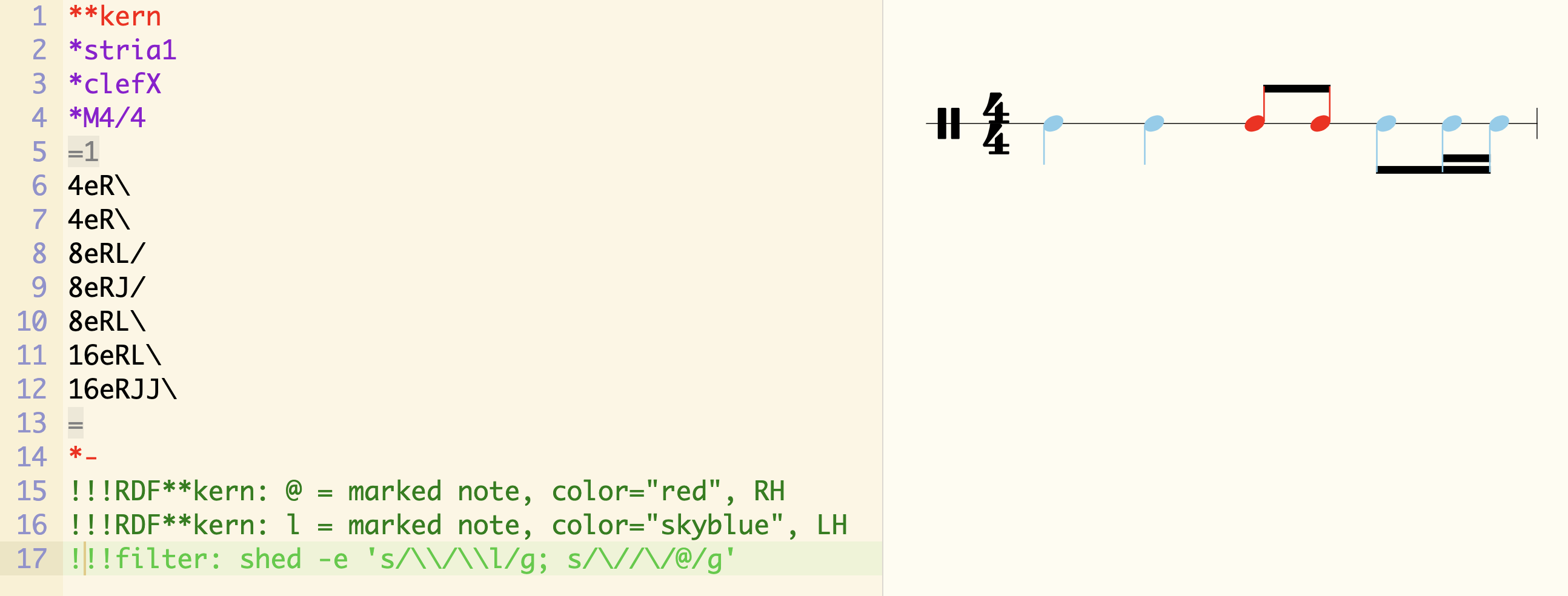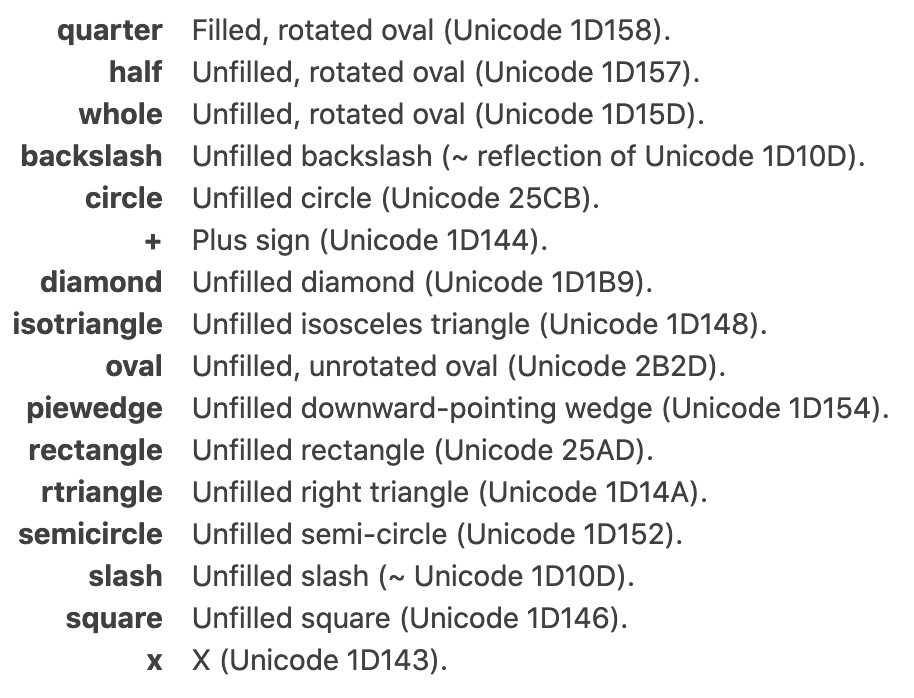Elaboration on why Humdrum not recommended as notation software?
43 views
Skip to first unread message
Daniel Clark
Jun 15, 2021, 3:34:28 PM6/15/21
to starstarhug
I've spent way too many hours over the past week evaluating the various notation software and syntax alternatives. Looking to transcribe notes from music lessons, and eventually play with algorithmic composition.
Humdrum's syntax and style just seem to make significantly more sense than anything else, and the main difficulty that I see so far - remembering what the various letters mean - is something trivial to learn via flashcards.
Specifically the main advantage I see is that humdrum syntax lets you easily maintain a sense of time going by, and where you are in a piece. I also love that it is designed to make you own microformats, which if I go with it I may end up eventually doing for the marching snare drum, as well as makes it easy to play with coloring and alternative output formats (for example, I'd like to make all notes played with the right hand red.)
However, in many places / FAQs, this type of use seems to be warned against. I'm wondering if someone could elaborate on why, and if those statements are actually still valid now that things like verovio seem to be pretty advanced.
Specifically if the only issues are with the visual beauty of printed output - e.g. stuff that only really matters if you are going to print and sell sheet music, like kerning etc. - I don't care, but if there are some functional things that are relatively commonly used but just not easily or at all doable for some subtle reason(s), that would make me pause.
Also, I think I noticed a few peculiar-to-percussion symbols not yet included [1], is stuff like that relatively easy to add?
Thanks,
-Danny
[1] Stuff like some alternative heads, see
Craig Sapp
Jun 15, 2021, 4:45:04 PM6/15/21
to stars...@googlegroups.com
Hello Daniel,
You are preaching to the choir here :-). A unique feature of Humdrum scores is that they are strictly ordered by time, which is a fairly direct representation of the layout of a graphical score (rotated 90 degrees). This is a design feature related to Humdrum's primary use for music analysis: the harmonic and melodic aspects of a note are both nearby in the data.
> However, in many places / FAQs, this type of use seems to be warned against.
Can you provide links to the specific notes about that? The main reason is that Humdrum was designed for music analysis, not music notation. Therefore there are limitations in what can be graphically displayed; however, this is more a limitation of focus rather than of potential capability. Humdrum does not have a native graphical music interface, so the data needs to first be converted into another format for rendering.
> I'm wondering if someone could elaborate on why, and if those statements are actually still valid now that things like verovio seem to be pretty advanced.
By "verovio", you mean Verovio Humdrum Viewer (VHV), which is currently the most advanced graphical renderer of Humdrum data. Most of the caveats were probably made before the existence of VHV. For example most of the Humdrum Toolkit was written around 1990-1995 and the documentation from 1995-2000, while VHV was created in 2016.
VHV uses verovio to create graphical music notation: https://www.verovio.org which is internally structured on MEI data and which it converts into SVG images of graphical music notation. I wrote the converter from Humdrum to MEI which is built into verovio and converts dynamically within the VHV webpage to make the Humdrum to SVG conversion seem nearly instantaneous.
> I also love that it is designed to make you own microformats,
That is easy to do with Humdrum, although mapping such representations to graphical notation can be more difficult (typically microformats are designed for computational analysis, where the notation is usually not necessary).
> makes it easy to play with coloring
Here are some demos of coloring in case you are not aware of them:
(1) You can add an interpretation such as *color:hotpink to a staff to color notes on the staff following the instruction:

(2) You can mark individual notes with user-assignable characters and give different colors to each marker:

(3) A more advanced example would be to color notes based on their stem directions (/ = upstem and \ = downstem):


Line 17 changes / to /@ and \ to \l before the music gets converted to SVG images.
> Also, I think I noticed a few peculiar-to-percussion symbols not
yet included [1], is stuff like that relatively easy to add?Graphical display of Humdrum percussion in VHV is fairly new (as of last year), so there are probably lots of missing components. In certain cases such as noteheads it can be easy to add new shapes. In order for graphical elements to be shown in VHV, they need to be implemented in verovio. And turn to display them with verovio, they need to be defined in MEI. So if they are defined in MEI and implemented in verovio, it is usually easy to add to VHV.


Here is the current list of noteheads possible with VHV:

MEI defines the following notehead shapes:

If there are any in this list that are not in VHV, I can add them very quickly, but I think that some are not yet available in verovio (see below).
If a notehead shape is not there, then it will have to be added to the MEI list first, probably requesting it here:
Then when it is added, request its inclusion in verovio here:
And then when implemented in verovio, request that it be added to VHV here:
-=+Craig
--
--
This is a message is from the **HUG newgroup.
To post to this group, send email to stars...@googlegroups.com
To unsubscribe from this group, send email to
starstarhug...@googlegroups.com
For more options, visit this group at
http://groups.google.com/group/starstarhug?hl=en
---
You received this message because you are subscribed to the Google Groups "starstarhug" group.
To unsubscribe from this group and stop receiving emails from it, send an email to starstarhug...@googlegroups.com.
To view this discussion on the web visit https://groups.google.com/d/msgid/starstarhug/8b5ae876-11ae-4b82-9d9d-8ee206c997a0n%40googlegroups.com.
Reply all
Reply to author
Forward
0 new messages
